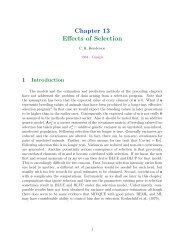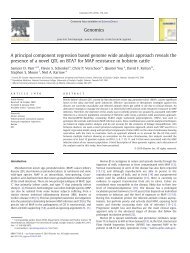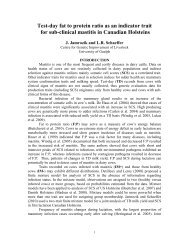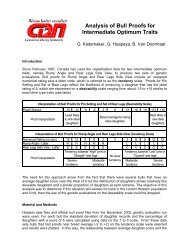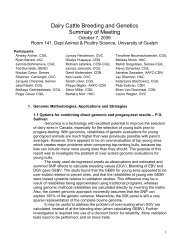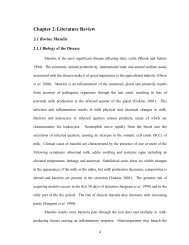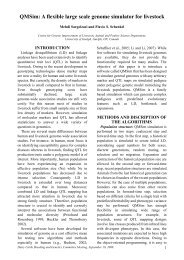September 2006 - CGIL
September 2006 - CGIL
September 2006 - CGIL
Create successful ePaper yourself
Turn your PDF publications into a flip-book with our unique Google optimized e-Paper software.
There seemed to be no clear relationship between the percentage of daughters with modified data<br />
and the ranking of sires. A question was posed as to whether it would be possible to apply a<br />
different method for outliers to yield traits than to SCS, since there tended to be more erroneous<br />
yield data compared with SCS. This method would be possible, but one would always have to<br />
keep in mind that there is a built-in correlation structure between the 4 traits in the model.<br />
DHI manipulates and screens data before sending it to CDN for inclusion in genetic evaluation. In<br />
addition, they also place holds on records until the subsequent test so that outlying records from<br />
the previous test can be validated. Record screening is only performed on yield traits, not on SCS.<br />
It was noted that this screening is only performed on a cow-to-cow comparison, not cow-to-herd<br />
basis. It was estimated that DHI screens approximately 3-5% of the records for inclusion in<br />
genetic evaluation. Calculating the percentage of records expected to be outliers would not easy<br />
since outlying records are defined by DIM and are specific to each cow and her predicted<br />
lactation curve. Producers are aware of DHI’s editing process so it is no longer beneficial to<br />
attempt to manipulate yields on one test day. This manipulation must be constantly conducted in<br />
order to go unrecognized. Due to owner-supervised testing, it is no longer beneficial to<br />
manipulate owner tests, since supervised tests will tend not to pass the editing process and be<br />
removed every time.<br />
Breeding Values are accounted for with the robust procedure, animals therefore animals that are<br />
outliers because of their superior genetics would not be discounted. The adjustment for<br />
heterogeneous variance and robust estimation procedures are interconnected. If heterogeneous<br />
adjustments were performed prior to estimation, then fewer outliers would be expected. It is<br />
possible to have a different k value for different traits.<br />
1.2 Phantom Genetic Groups and Genetic Trend<br />
Schaeffer<br />
At the previous technical meeting, the possibility of smoothing the effects of phantom genetic<br />
groups was proposed. In this study, a small (non-species specific) population was simulated to<br />
investigate the effects of different genetic grouping methods. Eight generations of selection (for<br />
two correlated traits) and matings were performed. Missing parents were randomly assigned,<br />
therefore results from this study mat not be as bias as they might be in the actual dairy cattle<br />
population. Four different models were investigated; a simple animal model, a model that<br />
included a year of birth effect, a model including phantom parent groupings, and lastly a model<br />
that included year of birth effects and phantom parent groupings. Three different percentages of<br />
unknown parents (0%, 10% and 25%) were simulated for each model. Variance components,<br />
breeding values and genetic trends were estimated.<br />
Correlations between the true BV and estimated BV were calculated. Only small differences<br />
between models were realized. The highest correlation was found for the simple animal (without<br />
year of birth effects or phantom groups). As the percentage of unknown parents increased, the<br />
correlation decreased. When year of birth effects are added to the model, unknown parents cause<br />
problems in estimating breeding values.<br />
Average inbreeding coefficients for animals born were summarized. As the percentage of<br />
unknown parents increased, the inbreeding coefficient decreased. Therefore when an increasing<br />
amount of the pedigree was missing, the inbreeding rate was significantly underestimated. No<br />
statistical differences between models were found when comparing genetic and residual variances<br />
and heritability. The simple animal model gave unbiased estimation for all pedigree structures.




